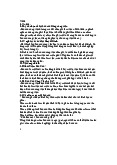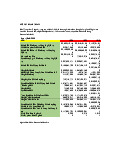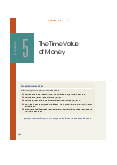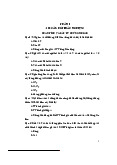



















Preview text:
Test Bank –Introductory Econometrics: A Modern Approach, 5th Edition by Je>rey M. Wooldridge
With PERFECT SOLUTION AVAILABLE OF ALL CHAPTERS Chapter 1
1. Econometrics is the branch of economics that _____.
a. studies the behavior of individual economic agents in making economic decisions b s
c. deals with the performance, structure, behavior, and decision-making of an economy as a whole
d. applies mathematical methods to represent economic theories and solve economic problems. Answer: b Di!culty: Easy Bloom’s: Knowledge A-Head: What is Econometrics? BUSPROG:
Feedback: Econometrics is the branch of economics that develops and uses
statistical methods for estimating economic relationships.
2. Nonexperimental data is called _____. a. cross-sectional data b a c. observational data d. panel data Answer: b Di!culty: Easy Bloom’s: Knowledge A-Head: What is Econometrics? BUSPROG: Feedback:
3. Which of the following is true of experimental data? a l s .
b. Experimental data cannot be collected in a controlled environment.
c. Experimental data is sometimes called observational data.
d. Experimental data is sometimes called retrospective data. Answer: a Di!culty: Easy Bloom’s: Knowledge A-Head: What is Econometrics? BUSPROG: Feedback:
4. An empirical analysis relies on _____to test a theory. a. common sense b. ethical considerations c a d. customs and conventions Answer: c Di!culty: Easy Bloom’s: Knowledge
A-Head: Steps in Empirical Economic Analysis BUSPROG:
Feedback: An empirical analysis relies on data to test a theory.
5. The term ‘u’ in an econometric model is usually referred to as the _____. a m b. parameter c. hypothesis d. dependent variable Answer: a Di!culty: Easy Bloom’s: Knowledge
A-Head: Steps in Empirical Economic Analysis BUSPROG:
Feedback: The term u in an econometric model is called the error term or disturbance term. 6 l _____.
a. include all unobserved factors a8ecting the variable being studied b d t t
c. refer to the explanatory variables included in the model
d. refer to the predictions that can be made using the model Answer: b Di!culty: Easy Bloom’s: Knowledge
A-Head: Steps in Empirical Economic Analysis BUSPROG:
Feedback: The parameters of an econometric model describe the direction and
strength of the relationship between the variable under study and the factors a8ecting it. 7 ? a. Collection of data b. Statement of hypotheses c l d. Testing of hypotheses Answer: c Di!culty: Easy Bloom’s: Knowledge
A-Head: Steps in Empirical Economic Analysis BUSPROG:
Feedback: The :rst step in empirical economic analysis is the speci:cation of the econometric model.
8. A data set that consists of a sample of individuals, households, :rms, cities,
states, countries, or a variety of other units, taken at a given point in time, is called a(n) _____. a t b. longitudinal data set c. time series data set d. experimental data set Answer: a Di!culty: Easy Bloom’s: Knowledge
A-Head: The Structure of Economic Data BUSPROG:
Feedback: A data set that consists of a sample of individuals, households, :rms,
cities, states, countries, or a variety of other units, taken at a given point in time, is
called a cross-sectional data set. 9. D e y s_____. a. panel data b. experimental data c. time series data d a Answer: d Di!culty: Easy Bloom’s: Application
A-Head: The Structure of Economic Data BUSPROG: Analytic Feedback: A , c s c n a .
10. A data set that consists of observations on a variable or several variables over
time is called a _____ data set. a. binary b. cross-sectional c s d. experimental Answer: c Di!culty: Easy Bloom’s: Knowledge
A-Head: The Structure of Economic Data BUSPROG:
Feedback: A time-series data set consists of observations on a variable or several variables over time.
11. Which of the following is an example of time series data?
a. Data on the unemployment rates in di8erent parts of a country during a year.
b. Data on the consumption of wheat by 200 households during a year. c .
d. Data on the number of vacancies in various departments of an organization on a particular month. Answer: c Di!culty: Easy Bloom’s: Application
A-Head: The Structure of Economic Data BUSPROG: Analytic Feedback: l v r t 0 y . 1 ?
a. Data on the unemployment rate in a country over a 5-year period b g c .
c. Data on the income of 5 members of a family on a particular year.
d. Data on the price of a company’s share during a year. Answer: b Di!culty: Easy Bloom’s: Application
A-Head: The Structure of Economic Data BUSPROG: Analytic Feedback: A l m t m .
13. Which of the following is a d l d ?
a. A panel data set consists of data on di8erent cross-sectional units over a given
period of time while a pooled data set consists of data on the same cross-sectional
units over a given period of time. b n p l u e
c. A panel data consists of data on a single variable measured at a given point in
time while a pooled data set consists of data on the same cross-sectional units over a given period of time.
d. A panel data set consists of data on a single variable measured at a given point in
time while a pooled data set consists of data on more than one variable at a given point in time. Answer: b Di!culty: Easy Bloom’s: Knowledge
A-Head: The Structure of Economic Data BUSPROG: Feedback: a g - s .
14. _____ has a causal e8ect on _____. a. Income; unemployment b. Height; health c n d. Age; wage Answer: c Di!culty: Moderate Bloom’s: Application
A-Head: Causality and the Notion of Ceteris Paribus in Econometric Analysis BUSPROG: Analytic
Feedback: Income has a causal e8ect on consumption because an increase in
income leads to an increase in consumption.
15. Which of the following is t e?
a. A variable has a causal e8ect on another variable if both variables increase or decrease simultaneously. b .
c. Di!culty in inferring causality disappears when studying data at fairly high levels of aggregation.
d. The problem of inferring causality arises if experimental data is used for analysis. Answer: b Di!culty: Moderate Bloom’s: Knowledge
A-Head: Causality and the Notion of Ceteris Paribus in Econometric Analysis BUSPROG:
Feedback: The notion of ‘ceteris paribus’ plays an important role in causal analysis.
16. Experimental data are sometimes called retrospective data. Answer: F e Di!culty: Easy Bloom’s: Knowledge A-Head: What is Econometrics? BUSPROG:
Feedback: Nonexperimental data are sometimes called retrospective data.
17. An economic model consists of mathematical equations that describe various
relationships between economic variables. Answer: True Di!culty: Easy Bloom’s: Knowledge
A-Head: Steps in Empirical Economic Analysis BUSPROG:
Feedback: An economic model consists of mathematical equations that describe
various relationships between economic variables. 1 l v . A e Di!culty: Easy Bloom’s: Knowledge
A-Head: The Structure of Economic Data BUSPROG:
Feedback: A time series data set consists of observations on a variable or several variables over time. 1 . A e Di!culty: Easy Bloom’s: Knowledge
A-Head: The Structure of Economic Data BUSPROG:
Feedback: A time series data is also called a longitudinal data set.
20. The notion of ceteris paribus means “other factors being equal.” Answer: True Di!culty: Easy Bloom’s: Knowledge
A-Head: Causality and the Notion of Ceteris Paribus in Econometric Analysis BUSPROG:
Feedback: The notion of ceteris paribus means “other factors being equal.” Chapter 2 1. A n) _____. a. explanatory variable b. control variable c. predictor variable
Y = response variable = dependent variable d. e
x = explanatory variable = independent variable Answer: d Di!culty: Easy Bloom’s: Knowledge
A-Head: De:nition of the Simple Regression Model BUSPROG:
Feedback: A dependent variable is known as a response variable.
2. If a change in variable x causes a change in variable y, variable x is called the _____. a. dependent variable b. explained variable c e d. response variable Answer: c Di!culty: Easy Bloom’s: Comprehension
A-Head: De:nition of the Simple Regression Model BUSPROG: Feedback: I s c .
3. In the equation y = β0 + β1 x + u, β0 is the _____. a. dependent variable b. independent variable c. slope parameter d r Answer: d Di!culty: Easy Bloom’s: Knowledge
A-Head: De:nition of the Simple Regression Model BUSPROG:
Feedback: In the equation y = β0 + β1 x + u, β0 is the intercept parameter.
4. In the equation y = β0 + β1 x + u, what is the estimated value of β0 ? ´ a. ´y 1x ´y +β ´x b. 1 y yi−´¿ ¿ ¿ c. (xi−´x)¿ n ∑ ¿ i=1¿ n d. ∑ xy i=1 Answer: a Di!culty: Easy Bloom’s: Knowledge
A-Head: Deriving the Ordinary Least Squares Estimates BUSPROG: ´ ´
Feedback: The estimated value of β y− ^ β 0 is 1x .
5. In the equation c = β0 + β1 i + u, c denotes consumption and i denotes ^ c
income. What is the residual for the 5t h c observation if 5 =$500 and 5 =$475? a. $975 b. $300 c 5 d. $50 Answer: c Di!culty: Easy Bloom’s: Knowledge
A-Head: Deriving the Ordinary Least Squares Estimates BUSPROG: Feedback: T th s ^ u ^ u =c − ^ c i
. In this case, the residual is 5 5 5 =$500 -$475= $25. ^ 6. What does the equation y= ^ β0+^
β1 x denote if the regression equation is y = β0 + β1x1 + u?
a. The explained sum of squares b. The total sum of squares c n
d. The population regression function Answer: c Di!culty: Easy Bloom’s: Knowledge
A-Head: Deriving the Ordinary Least Squares Estimates BUSPROG: Feedback: T e g .
7. Consider the following regression model: y = β0 + β1x1 + u. Which of the following
is a property of Ordinary Least Square (OLS) estimates of this model and their associated statistics?
a. The sum, and therefore the sample average of the OLS residuals, is positive.
b. The sum of the OLS residuals is negative.
c. The sample covariance between the regressors and the OLS residuals is positive. ´x ´y d. The point ( ,
) always lies on the OLS regression line. Answer: d Di!culty: Easy Bloom’s: Knowledge
A-Head: Properties of OLS on Any Sample of Data BUSPROG: Feedback: A ´ ´ ) a =´x , e o ´ . y =β +β x +u
8. The explained sum of squares for the regression function, i 0 1 1 1 , is de:ned as _____. n a. ∑ ( y −´y )2 i i=1 n 2 b. ∑ i=1 n c. ∑ ^ ui i=1 n d. ∑ (u )2 i i=1 Answer: b Di!culty: Easy Bloom’s: Knowledge
A-Head: Properties of OLS on Any Sample of Data




